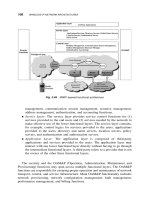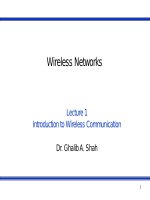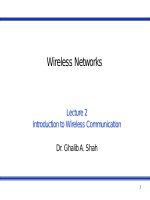Wireless networks - Lecture 4: Error detecting and correcting techniques
Bạn đang xem bản rút gọn của tài liệu. Xem và tải ngay bản đầy đủ của tài liệu tại đây (452.37 KB, 24 trang )
Wireless Networks
Lecture 4
Error Detecting and Correcting Techniques
Dr. Ghalib A. Shah
1
Outlines
Review of previous lecture #3
Transmission Errors
Parity Check
Cyclic Redundancy Check
Block Error Code
Summary of today’s lecture
2
Last Lecture Review
Multiplexing
► FDM, TDM
Transmission Mediums
► Guided media
► Unguided media
•
•
•
Microwave
Radio waves
Infra red
Propagation modes
► Ground wave propagation
► Sky-wave propagation
► LOS propagation
Multi-path propagation
Fading
3
Coping with Transmission Errors
Error detection codes
► Detects the presence of an error
Error correction codes, or forward correction codes
(FEC)
► Designed to detect and correct errors
► Widely used in wireless networks
Automatic repeat request (ARQ) protocols
► Used in combination with error detection/correction
► Block of data with error is discarded
► Transmitter retransmits that block of data
4
Error Detection Process
Transmitter
► For a given frame, an error-detecting code (check bits) is
calculated from data bits
► Check bits are appended to data bits
Receiver
►
►
►
►
Separates incoming frame into data bits and check bits
Calculates check bits from received data bits
Compares calculated check bits against received check bits
Detected error occurs if mismatch
5
Error Detection
Transmitter
Receiver
• Error detection not 100% reliable!
• protocol may miss some errors, but rarely
• larger EDC field yields better detection and correction
6
Parity Checks
Single bit
Even or Odd parity
Only single bit error detection
What about multiple bit errors
Use when probability of bit errors is small and
independent
Errors are usually clustered together
The ability of receiver to both detect and correct errors
is known as forward error correction (FEC)
7
Examples of parity bit check
Adding parity bit
110001011
110001010
Odd parity errors
110101011
110100011
Odd
Even
error detected
error undetected
8
Two-dimensional parity checks
Generalization of 1-bit
D bits are divided into i rows and j columns.
D1,1
D1,2
… D1,j
D1,j+1
D2,1
D2,2
… D2,j
D2,j+1
.
.
.
.
.
.
… .
… .
… .
.
.
.
Di,1
Di,2
… Di,j
Di,j+1
Di+1,1 Di+1,2 … Di+1,j Di+1,j+1
Receiver can not only detect but correct as well using row,
9
column indices
Example of 2D Odd parity check
1110010101111010
Let i =4, j =4
1110
0101
0111
1010
1001
Parity bits
0
1
0
1
1
1110
0001
0111
1010
1001
0
1
0
1
1
Error detection/correction
1110
0011
0111
1010
1001
0
1
0
1
1
Error detection/ no correction
10
Cyclic Redundancy Check (CRC)
Transmitter
► For a k-bit block,
transmitter generates an
(n-k)-bit frame check
sequence (FCS)
► Resulting frame of n bits
is exactly divisible by
predetermined number
Receiver
► Divides incoming frame
by predetermined number
► If no remainder, assumes
no error
Algorithm
► Generator: Transmitter
and receiver agree on an
r +1 bit pattern P.
► Transmitter chooses r
additional bits to append
with k data bits.
► Which is remainder of d /
P.
► Receiver: if remainder of
D / P is 0 , success
otherwise error
11
CRC using Modulo 2 Arithmetic
Exclusive-OR (XOR) operation
Parameters:
•
•
•
•
•
•
T =n-bit frame to be transmitted
D =k-bit block of data; the first k bits of T
F =(n – k)-bit FCS; the last (n – k) bits of T
P =pattern of n–k+1 bits; this is the predetermined divisor
Q =Quotient
R =Remainder
12
CRC using Modulo 2 Arithmetic
For T/P to have no remainder, start with
T
2
n k
D F
Divide 2n-k D by P gives quotient and remainder
2n
k
D
P
Q
Use remainder as FCS
T
2
n k
R
P
D R
13
CRC using Modulo 2 Arithmetic
Does R cause T/P have no remainder?
T
P
2n k D R
P
2n k D
P
R
P
Substituting,
T
P
Q
R
P
R
P
Q
R R
P
Q
► No remainder, so T is exactly divisible by P
14
CRC Example
Let d =10111, P=1001
Q
101011
P
1001
`P(X) =X3 +1
101110000
1001
1010
1001
D
1100
1001
1010
1001
011
T = 10111011
R
15
CRC using Polynomials
All values expressed as polynomials
► Dummy variable X with binary coefficients
X n kD X
P X
T X
Q X
X n kD X
R X
P X
R X
16
CRC using Polynomials
Widely used versions of P(X)
► CRC–12
•
X12 +X11 +X3 + X2 + X + 1
► CRC–16
•
X16 +X15 +X2 + 1
► CRC – CCITT
•
X16 +X12 +X5 + 1
► CRC – 32
•
X32 +X26 +X23 + X22 +X16 + X12 + X11 +X10 +X8 +X7 +X5 +X4 +X2 +X
+1
17
Wireless Transmission Errors
Error detection requires retransmission
Detection inadequate for wireless applications
► Error rate on wireless link can be high, results in a
large number of retransmissions
► Long propagation delay compared to transmission
time
18
Block Error Correction Codes
Transmitter
► Forward error correction (FEC) encoder maps each
k-bit block into an n-bit block codeword
► Codeword is transmitted; analog for wireless
transmission
Receiver
► Incoming signal is demodulated
► Block passed through an FEC decoder
19
20
FEC Decoder Outcomes
No errors present
► Codeword produced by decoder matches original
codeword
Decoder detects and corrects bit errors
Decoder detects but cannot correct bit errors;
reports uncorrectable error
Decoder detects no bit errors, though errors
are present
21
Block Code Principles
Hamming distance – for 2 n-bit binary sequences, the
number of different bits
► E.g., v1=011011; v2=110001;
► 011011 XOR 110001 =101010
► d(v1, v2)=3
Redundancy – ratio of redundant bits to data bits
Code rate – ratio of data bits to total bits
Coding gain – the reduction in the required E b /N 0 to
achieve a specified BER of an error-correcting coded
system
22
Block Codes
The Hamming distance d of a Block code is the
minimum distance between two code words
Error Detection:
► Upto d-1 errors
Error Correction:
► Upto
d 1
2
23
Example of Block code
Let k =2, n =5
Data block
Codeword
00
01
10
11
00000
00111
11001
11110
Suppose we receive 0 0 1 0 0 pattern
Minimum distance is with codeword 0 0 0 0 0,
so we deduct 0 0 as data bits.
24









